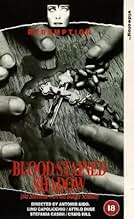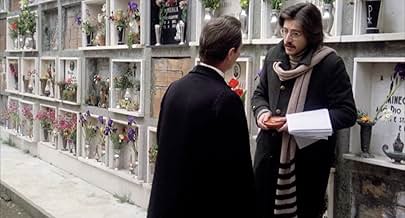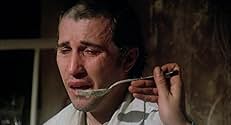IMDb RATING
6.3/10
2.2K
YOUR RATING
The body of a schoolgirl is found in a meadow. The murderer is never caught, and years later, a young man named Stefano returns to the island and is reunited with his brother, the local prie... Read allThe body of a schoolgirl is found in a meadow. The murderer is never caught, and years later, a young man named Stefano returns to the island and is reunited with his brother, the local priest.The body of a schoolgirl is found in a meadow. The murderer is never caught, and years later, a young man named Stefano returns to the island and is reunited with his brother, the local priest.
Craig Hill
- Don Paolo
- (as Graig Hill)
Alina De Simone
- Medium
- (as Alina Simoni)
Sonia Viviani
- Girl walking with Signora Nardi
- (as Sonia Vivani)
Fortunato Arena
- Antonio, Innkeeper
- (uncredited)
Antonio Bido
- Man at cemetary
- (uncredited)
Eolo Capritti
- Customer in restaurant
- (uncredited)
Featured reviews
Directed by Antonio Bido, this is by far his best film of his career (Though, admittedly, his only other film of any note is the 1977 Giallo "Watch Me When I Kill").
The film's narrative is relatively typical of a giallo: Someone is killing people in a small village and a priest tries to unravel the mystery of the killer's identity. What's atypical is the film's tone. The film is noteworthy for being one of the more serious and mature of the giallo genre. Bido avoids the giallo's often sleazy nature and embraces the Gothic and religious aspects instead.
Another interesting point is how the film focuses on two main protagonists, the priest and his brother, and how they collaborate with one another to discover the killer. Interesting narrative method having two focal points rather than one, not original but unconventional.
The performances are generally good with Craig Hill as giving an impressive performance as the priest. He exhibits a broad range of emotions from anger to sorrow, from determination to helplessness, and makes it totally convincing.
The cinematography is main feature of the film because it is its strongest trait. The visuals portray a wet and muggy Italy, with fog and mist enveloping the landscapes and rain falling, creating pools of water. This all builds a gloomy and foreboding atmosphere that conveys feelings of isolation, loneliness, dread, anguish, and death.
The characters are generally good as well, each with a strong history and believable relationships between one another. The greatest of which is the relationship between the priest and his brother, which is totally believable because not only of both of their performances, but also the development of their characters.
And lastly, the film features some wonderful aesthetic qualities through it's use of editing. Bido inter splices Catholic and Religious imagery to make comments about the characters and the religious institution as a whole.
The film has a few problematic issues. First of all, the narrative isn't clearly focused. The film appears to be more concerned with the visuals and the individual, isolated events in the film rather than the mystery as a whole. Thus, this damages the film's impact as it approaches the end, because here the mystery plays center stage but is underdeveloped.
The narrative also suffers from several of the genre's conventions and clichés, thus leading to a sort of predictability of the story. The film features the typical gloved killer, the extended stalking sequences leading to a gruesome death, the multiple red herrings, childhood traumas, and a host of other archetypes of the giallo.
Also, the final revelation stretches plausibility and thus may become unacceptable to some viewers, especially when one recalls the events that have transpired throughout the film.
Never the less, this is one of the better giallos out there.
Recommended to those who enjoy the mystery/thriller genre, though it is not essential unless you are a fan of the giallo genre. For the casual film viewer, there are better examples of the giallo genre and thus would recommend that you skip this and view one of the apexes of the genre such as Suspiria.
The film's narrative is relatively typical of a giallo: Someone is killing people in a small village and a priest tries to unravel the mystery of the killer's identity. What's atypical is the film's tone. The film is noteworthy for being one of the more serious and mature of the giallo genre. Bido avoids the giallo's often sleazy nature and embraces the Gothic and religious aspects instead.
Another interesting point is how the film focuses on two main protagonists, the priest and his brother, and how they collaborate with one another to discover the killer. Interesting narrative method having two focal points rather than one, not original but unconventional.
The performances are generally good with Craig Hill as giving an impressive performance as the priest. He exhibits a broad range of emotions from anger to sorrow, from determination to helplessness, and makes it totally convincing.
The cinematography is main feature of the film because it is its strongest trait. The visuals portray a wet and muggy Italy, with fog and mist enveloping the landscapes and rain falling, creating pools of water. This all builds a gloomy and foreboding atmosphere that conveys feelings of isolation, loneliness, dread, anguish, and death.
The characters are generally good as well, each with a strong history and believable relationships between one another. The greatest of which is the relationship between the priest and his brother, which is totally believable because not only of both of their performances, but also the development of their characters.
And lastly, the film features some wonderful aesthetic qualities through it's use of editing. Bido inter splices Catholic and Religious imagery to make comments about the characters and the religious institution as a whole.
The film has a few problematic issues. First of all, the narrative isn't clearly focused. The film appears to be more concerned with the visuals and the individual, isolated events in the film rather than the mystery as a whole. Thus, this damages the film's impact as it approaches the end, because here the mystery plays center stage but is underdeveloped.
The narrative also suffers from several of the genre's conventions and clichés, thus leading to a sort of predictability of the story. The film features the typical gloved killer, the extended stalking sequences leading to a gruesome death, the multiple red herrings, childhood traumas, and a host of other archetypes of the giallo.
Also, the final revelation stretches plausibility and thus may become unacceptable to some viewers, especially when one recalls the events that have transpired throughout the film.
Never the less, this is one of the better giallos out there.
Recommended to those who enjoy the mystery/thriller genre, though it is not essential unless you are a fan of the giallo genre. For the casual film viewer, there are better examples of the giallo genre and thus would recommend that you skip this and view one of the apexes of the genre such as Suspiria.
The Bloodstained Shadow doesn't do anything you haven't seen a million times over and the killer is so obvious from the start that you spend most of the overstuffed run time wondering why no one is calling out this person. It doesn't have the style, excess, or general unease of an Argento giallo and, instead, feels uncomfortably sandwiched somewhere in between a movie of the week and a less spirited episode of Murder, She Wrote: Jessica Goes To Italy.
There are a few attempts at the sleaze a lot of giallos are known for, but it's a mostly polite, too-classy affair with only the occasional instance of camp when a priest and child molesting piano teacher have a battle over who is more corrupt.
The characters are poorly drawn and uninteresting to follow and the film just doesn't seem to understand this and treats us to long sequences of them going about their day to day lives. Even worse, most of the murder scenes (the highlight of just about any giallo) aren't very creative or interesting.
There are a few attempts at the sleaze a lot of giallos are known for, but it's a mostly polite, too-classy affair with only the occasional instance of camp when a priest and child molesting piano teacher have a battle over who is more corrupt.
The characters are poorly drawn and uninteresting to follow and the film just doesn't seem to understand this and treats us to long sequences of them going about their day to day lives. Even worse, most of the murder scenes (the highlight of just about any giallo) aren't very creative or interesting.
Watch Me While I Kill wasn't the best giallo in the world, so it's nice to Antonio Bido step things up a bit in this one, even though it's nearly two hours long.
In a place that isn't quite Venice but nearby, young Stefano returns home to stay with his brother, a local priest. Stefano suffers from flashbackitis, a disease where he keeps seeing a small crying child, but it's not all doom and gloom because it looks like local lass Stefania Casini is into him.
His priest brother is also a bit of a gossip, and fills Stefano in on the local freaks, including a phoney medium who may or may not be blackmailing her customers, which includes a backstreet abortionist with a dark secret, a doctor, and some rich gay guy who could also be a nonce. Then there's Andrea, the bereaved father of a girl we saw murdered at the start of a film, and Stefania Casini's crippled stepmother, who paints pictures, one of which sets off Stefano's flashbacks! Its like Eastenders, really.
After someone rather stupidly murders the medium in front of the priest's house, the priest starts receiving death threats, Stefano embarks on an investigation (while also putting the moves on Stefania Casini), and someone pulls on those old black gloves to do some murdering...
While overlong and very Argento-like, this is still a solid giallo with loads of twists and turns, and plenty of atmosphere too, due to the almost-Venice setting (I probably should have looked up where this takes place). There was enough going on to keep me entertained, and although I did eventually figure out who the killer was, I was still pretty satisfied by the proceeding.
You could also make a game out of what scene you've previously witness in a preceeding Giallo film: the Cemetary scene from Cat O Nine Tails, the crazy son hidden by his mother in Case of The Bloody Iris, the clue in the painting from Bird With The Crystal Plumage. Some people hate this one by the way.
In a place that isn't quite Venice but nearby, young Stefano returns home to stay with his brother, a local priest. Stefano suffers from flashbackitis, a disease where he keeps seeing a small crying child, but it's not all doom and gloom because it looks like local lass Stefania Casini is into him.
His priest brother is also a bit of a gossip, and fills Stefano in on the local freaks, including a phoney medium who may or may not be blackmailing her customers, which includes a backstreet abortionist with a dark secret, a doctor, and some rich gay guy who could also be a nonce. Then there's Andrea, the bereaved father of a girl we saw murdered at the start of a film, and Stefania Casini's crippled stepmother, who paints pictures, one of which sets off Stefano's flashbacks! Its like Eastenders, really.
After someone rather stupidly murders the medium in front of the priest's house, the priest starts receiving death threats, Stefano embarks on an investigation (while also putting the moves on Stefania Casini), and someone pulls on those old black gloves to do some murdering...
While overlong and very Argento-like, this is still a solid giallo with loads of twists and turns, and plenty of atmosphere too, due to the almost-Venice setting (I probably should have looked up where this takes place). There was enough going on to keep me entertained, and although I did eventually figure out who the killer was, I was still pretty satisfied by the proceeding.
You could also make a game out of what scene you've previously witness in a preceeding Giallo film: the Cemetary scene from Cat O Nine Tails, the crazy son hidden by his mother in Case of The Bloody Iris, the clue in the painting from Bird With The Crystal Plumage. Some people hate this one by the way.
Sounds a bit strange that Antonio Bido just had few movies as director until now, this second entry on Giallo where he co-wrote and directed, however was his final movie in this specific genre, here he brings a holy figure of the Church, a Priest Don Paolo (Craig Hill) when arrives nearby Venice his young brother Stefano (Lino Capolicchio) a professor stressed by strange visions of the past over an unsolved murder of a girl, Lino has an occasional meeting at train's cabin with Sandra (The eye candy Stefania Casini), Lino was received warmly by Don Paolo, implying a true fraternal feelings, the Priest introduces to Lino his worries over weird facts in the little community, about a small group consisting by a Medium, a Doctor, a Middle age woman and a decaying drunkard Count, soon starts other crimes, even linked on those small group pointed out by Don Paolo, wisely the Director puts countless clues trying deceives the viewer, also Bido exposes on slight portions two sensitive matter which the Church faces nowadays, one woman complains to the Priest that his boy has been abused by the Count Pedrazzi (Massimo Serato) on his confession, indeed the rotten Count probable did such backbiting, due it was widely clear on his odd behavior with your butler, further he presents the Priest as all we know recognize as an unambiguous character, good movie!!
Resume:
First watch: 2020 / How many: 1 / Source: DVD / Rating: 7
Resume:
First watch: 2020 / How many: 1 / Source: DVD / Rating: 7
Nothing more than an honest italian giallo, this movie tells the torbid story of a string of murders in a small town in the Venice laguna. A young mathematician will find the answer to one of his early nightmares, but he will not like the taste of it. A good music and a good atmosphere don't totally hide a lacking script (a few of the acts of the murderer are without a real, logical explanation), but this is the norm in several of more routinely italian gialli.
Did you know
- TriviaAt 28'51' when Capolicchio introduces himself to Stefania Casini he tells her he is a Professor of Mathematics, Casini tells him that her job is to deal with furniture and Capolicchio calls her Architect, Stefania Casini actually graduated in Architecture at Polythechnic University of Milan.
- GoofsWhen the killer is being revealed and the main character pulls out the newspaper article, you can see and hear a flash from camera, probably taking pictures of the scene.
- ConnectionsFeatured in Solamente Bido (2002)
- How long is The Bloodstained Shadow?Powered by Alexa
Details
- Runtime
- 1h 49m(109 min)
- Sound mix
- Aspect ratio
- 1.85 : 1
Contribute to this page
Suggest an edit or add missing content












